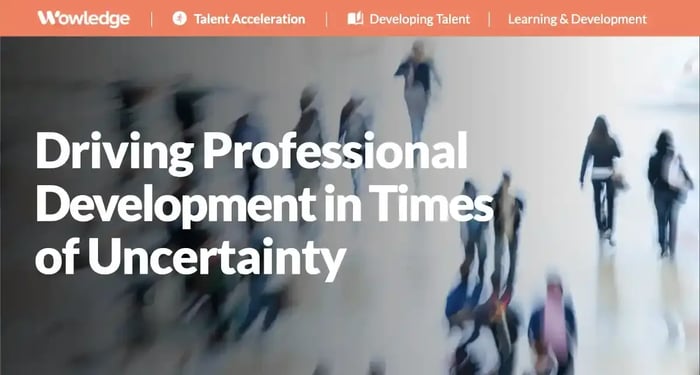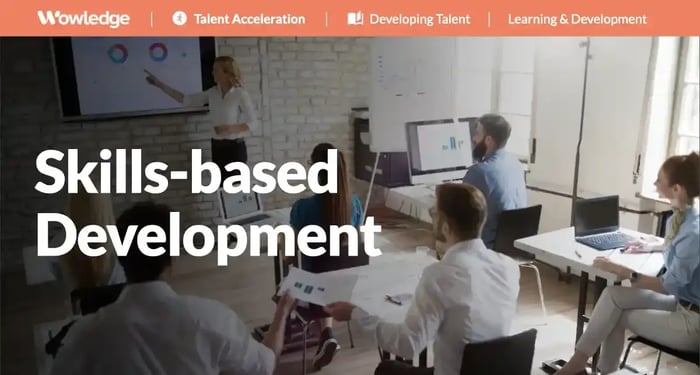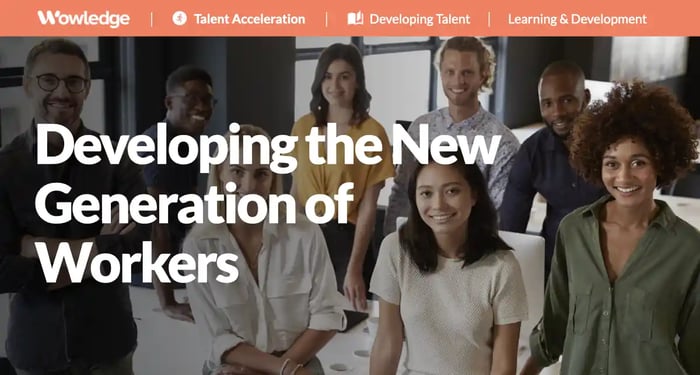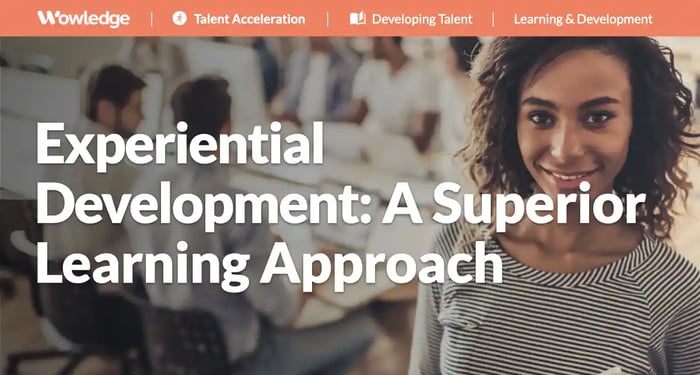Table of Contents
- Why aren’t employees grooming themselves and investing in their own professional development?
- 1. Uncertainty as to what is needed for their current jobs
- 2. Lack of understanding as to what is needed for promotions
- 3. Ambiguity as to what skills their organization needs in the future
- 4. Lack of good coaching and mentoring or even good feedback on current performance
- 5. Vagueness as to what professional development opportunities exist inside or outside of the company
- 6. Insufficient budgets to pay for professional development programs
- 7. Not enough time to devote to professional development
- What can HR do to support employees’ professional development?
- Start small, and with a plan
- Relevant Practices & Tools
- FAQs
As the war for talent continues unabated, even with the current layoffs in the tech sector, many organizations are finding that candidates are lacking in certain competencies necessary for success. With Baby Boomers moving on to their “second acts,” and GenXers, a smaller generation, also heading towards their own retirements, organizations are finding it necessary to advance Millennial and GenZ employees to positions they may not be ready for. The talent pools both inside and outside of organizations, in many cases, include high potentials who need more preparation. Driving professional development in times of uncertainty is crucial.
Organizations are also finding it hard to keep their best talent as opportunities abound in certain professions. Attracting and retaining critical skills, as well as promoting diversity, equity and inclusion, while creating an engaging environment calls for a culture that promotes learning and professional development. Employees are demanding more professional development, yet training budgets don’t always keep up.
On top of these talent issues, organizations are in a state of continual flux and change. Jobs continue to change all the time as the business and industry change. The skills and competencies needed for today’s jobs aren’t necessarily what will be needed next year. New professions, like data analytics, have sprung up seemingly out of nowhere over the last decade. The impact of artificial intelligence on the future workforce means some jobs and professions will change dramatically or even disappear. Educational institutions scramble to meet the needs of these new professions by offering degree programs and certifications, and organizations do their best to upskill or reskill their workforce.
Keeping oneself up to date on the current plus future skills needed is the key to success for all professionals. Keeping oneself competitive for advancement in one’s profession means having the right skills, knowledge, competencies, and experience. Being viewed as the “obvious” choice for a new position or promotion in place takes professional development.
Why aren’t employees grooming themselves and investing in their own professional development?
Some of the more common reasons that employees aren’t investing in themselves and their careers include:
1. Uncertainty as to what is needed for their current jobs
So many job descriptions are outdated, that employees aren’t always sure what is expected of them. Keeping job descriptions current is difficult when organizations and jobs change so frequently. Oftentimes, “other duties as assigned” become most of the work performed.
2. Lack of understanding as to what is needed for promotions
Because job descriptions may be outdated, it causes confusion over promotion criteria. Career paths are often unclear, and the requirements for higher-level positions remain unknown.
3. Ambiguity as to what skills their organization needs in the future
Strategic plans are not always shared with employees due to their competitive nature. This leads employees to determine for themselves if there is a future at their current place of employment.
4. Lack of good coaching and mentoring or even good feedback on current performance
HR has put the onus on talent development, including providing feedback, coaching, and mentoring on leadership. Many leaders are not skilled at doing this, and many don’t have much more information about careers than their employees. Some HR departments offer career or performance coaching for their employees, but they may not be able to reach everyone in the organization with these services.
5. Vagueness as to what professional development opportunities exist inside or outside of the company
Many organizations have extensive e-learning libraries that go untouched because the employees simply don’t know they are available. Or, they don’t know what to take because they don’t know what is appropriate for their current job or for their development needs. Additionally, employees may be aware of publicly available programs, like LinkedIn Learning, or professional conferences, but may have little time to access them.
6. Insufficient budgets to pay for professional development programs
Training budgets ebb and flow with the organization’s needs, and whether the organization has the funds or not, there must be some demonstrated need for the program before any funds can be expended.
7. Not enough time to devote to professional development
According to Easy LMS, in 2020, the average employee spent 102 hours annually on learning. That is only 1% of their time, which equates to 24 minutes a week for full-time workers ("How long should employee training be?"). Working long hours and trying to strike a good work-family balance is nothing new in the US. This has been a decades-long problem that has been addressed through various regulations (e.g., FMLA) and company practices (e.g., PTO, hybrid work). Nevertheless, the expectation for most workers is that they are available at nights and weekends to read and respond to emails or finish a project or other assignment that can interfere with their personal lives. With so much pressure, workers are finding that some things just must go—e.g., exercise, reading for pleasure, relaxing, and time to eat a nutritious meal—things that contribute to their well-being. Many times, professional development falls to the bottom of the “to-do” list.

What can HR do to support employees’ professional development?
Organizations want employees who are engaged in their work and find their employment experiences meaningful. Many provide professional development opportunities to help employees achieve their career goals as well as enhance their current performance. But career development is a two-way street, i.e., the employee must show interest in their careers and work together with their organizations to enhance their skills, knowledge, and competence. How can HR better develop the talent in the organization and engage its employees in professional development activities? Driving professional development in times of uncertainty is core to this.
- Understand where the company is going in the foreseeable future and in the longer term. What skills are, and will be, needed to be successful.
- Know the talent the company already has- the skills, competencies, and experience. Is there a gap between what the company needs now and in the future?
- Develop a talent development strategy for closing the identified gaps. Ideally, this should be a part of the organization’s strategic plan, but if it is not, make the business case to get the resources needed to achieve the plan.
- Determine how the company can close gaps through professional development. What can be offered internally? Who should be sent to an external program? What partnerships can be made with external providers to develop the necessary skills?
- Help employees and managers understand how the organization works by clearly communicating the information they need to make informed career decisions. What career paths are available? Where do they lead? What are the requirements for advancing? What other careers or jobs are anticipated over the next several years? Where is the company’s business headed? How can one be prepared for these new opportunities? Employees oftentimes don’t realize that all career paths have an endpoint either as a senior individual contributor or as a people leader. If they desire to advance to a leadership position, be sure to include the leadership competencies necessary for these positions in any communication.
- Assist with career planning by offering one-on-one coaching through HR or through an external coach. Career coaches examine skills, interests, and values to help individuals form career goals and career development needs. HR professionals know that it is best for employees to love the work they do vs. being attracted to a field they have no interest in just because it pays better or there may be abundant opportunities. Doing what one loves uses one’s talents, helps keep engagement up, and brings more satisfaction. Being stuck in the wrong career can make life miserable and ultimately can lock one into a career that is unrewarding. Career coaches can also help individuals develop a written 2-5 years career plan based on their skills, interests, and values, plus information gleaned from information interviews, mentors, the organization’s strategic direction, and trends in the industry/profession. It all starts with a game plan to help point to the requisite development areas. There are plenty of templates and books that can help employees formulate their goals and action plans. Having these resources all in one area on the Intranet, LMS, or in HR can help employees do their own work.
- Provide formal mentoring and coaching programs. Organizations depend on managers to coach their employees, yet many managers are either not trained to do this or they lack the skill to do it properly. Training managers in basic communication skills can help enhance the coaching they provide. Weave the requirement that managers coach employees into the organization’s culture by making it part of the performance management process and policy. If the organization can afford it, find external, certified coaches who can provide executive coaching to the leadership team.
- Market what your organization offers. Many organizations have robust talent development courses, knowledge management centers, career centers, educational reimbursement policies, certifications, and reimbursements for conferences, coaching, and other forms of professional development, yet employees don’t know they exist. Many HR offices have a portal for all things HR, including learning and development. Let employees know where to find everything. If you are not familiar with marketing, there are plenty of training courses and resources available that focus on marketing HR and learning.
- Be sure to sponsor or host in the learning management system (LMS) short bursts of learning, called “micro-learning”. Micro-learning has been around for decades to help busy employees access professional development programs. According to Surge9, microlearning is an approach to training characterized by brief learning modules comprising bite-sized learning activities delivered over mobile devices and designed for quick consumption. Even if your organization has e-learning available, that may not be sufficient as the content can be outdated soon after its release, according to Surge9.
- Use technology to your advantage. Many LMS systems have features that don’t get used. For example, if your LMS allows for role-based learning, spend the time developing recommendations and requirements for specific classes based on the specific job. Push these courses out to the appropriate employees. Find other ways to use the technology you have to enhance the professional development of the employees.
- Provide free “lunch and learn” sessions where employees attend a program in their free time during lunch. (If your employees are still working on-site, buy lunch for the attendees.) Typically, these are speakers who lecture on a specific topic, a book club, or a micro-learning session on a specific topic.
- Create communities of practice where like-minded employees in a particular job category (e.g., all new hires; all engineers; all supervisors, etc.) meet on their own time to discuss topics of importance, share knowledge, or get to know one another.
- Professional development is a two-way streetwith employees doing their part and the organization and manager doing their parts. Here are some DIY Professional Development activities that employees can use. Again, marketing their availability is crucial.
- Books: either e-books, audiobooks, or printed books
- Videos, like YouTube and Ted Talks
- Professional journals and memberships
- Podcasts and webinars
- Open-source education like LinkedIn Learning and other platforms
- Conferences: Keeping current with thought leaders and trends and sharing that knowledge
- Some professional development activities are free; others cost money. Some organizations have reimbursement policies that require upfront out-of-pocket payment and proof of completion before they will reimburse. This may stop employees from availing themselves of these specific opportunities if they cannot afford the payment. A change in policy may be helpful to have the employees receive the payment upfront.
- Consider ways to incentivize employees on completing their development plans. If a promotion cannot be granted when an employee earns a bachelor’s degree, what could be done? If compensation is not available for completing professional development goals, what other non-compensation-type incentives could be used? Sometimes the best incentives (e.g., time off) are the least costly.
Start small, and with a plan
Depending on the size of the company and the available resources, the Human Resources function may not be able to do many of the suggested activities in this article. Start small and start with a plan. Over time, the culture will shift to one where employees, HR, and management work together for the betterment of all. Professional development can be a game changer for the organization and the employee.
Relevant Practices & Tools
Advanced Learning and Development Practices to Accelerate Skill and Capability Growth. >
These practices focus on developing, staffing, and managing a learning and development function that is highly responsive to business needs, employing both technology and non-classroom methods to effectively enhance employee knowledge, skills, and abilities (KSAs)... more »
Creating Informal Learning and Experiential Development Opportunities for Cost-effective Delivery. >
Informal learning includes any learning or development activity that a) takes place outside of a formal classroom or educational setting, b) is self-initiated or guided, and c) aims to improve or develop practical knowledge, skills, and abilities (KSAs) for a current job or aspirational role... more »
Creating a Learning Culture that Supports Career-long Education and Development. >
A learning culture encourages and supports the organization and its employees' ongoing pursuit of knowledge and growth, promotes the sharing of learning with others, and motivates everyone to continually upgrade their knowledge, skills, and abilities... more »
Selecting and Developing Employee Coaches and Mentors as Internal Resources. >
Selecting and developing internal coaches and mentors requires planning and structure to ensure that a) the right people are in place and b) they are properly prepared and managed to provide guidance and development to individuals in the most impactful roles in the organization... more »
The Individual Development Plan (IDP) Tool: Capture Targeted Employee Learning and Development Actions for a Performance Period. >
A plan of action to guide the employee throughout the coming performance period (e.g., year) as they continue to develop necessary knowledge, skills, abilities, and competencies for both meeting current and preparing for future job role requirements... more »
FAQs
How can HR build a simple, professional development plan with a limited budget?
Start by choosing a few high-need skills tied to the business plan and mapping free or low-cost learning to each one. Use micro-learning, internal experts, and peer circles to keep costs down and access high. Fund only a few paid programs for critical roles responsible for strategically-critical or near-term results, and measure wins to justify more budget later.
What can managers do weekly to help their employees grow their skills without long classes?
Hold a 15-minute check-in that covers recent successes or project completions, any barriers to task or project success they are currently experiencing, and one assigned task that is tied to a new or enhanced skill development goal. Give a simple stretch assignment or project and set a date to review results. Keep it light but steady so growth becomes part of normal work.
How can HR market learning so people actually use it?
Treat it like a campaign, with planned and coordinated short emails, leadership and managerial talking points, and a one-page “start here” guide by role. Share short success stories and show how those who participated actively in their development advanced upward or laterally to jobs they aspired to. Engage employees in rating learning content by its value or utility, delivery satisfaction, and ease of access and use. Repeat monthly and make managers the messengers.
How can mentoring and coaching be set up quickly and fairly?
Match pairs of experienced and influential leaders and subject matter experts who have been evaluated for their interpersonal skills and style. Identify the most suitable mentors and coaches based on the employee’s development-targeted skills and goals, not only job titles. Give a simple meeting guide to both parties, set a 12-week run, and ask them to identify and document one shared goal, such as a finished project or improved presentation skills. Offer office-hour time slots with trained coaches for tough topics that direct supervisors cannot cover.










